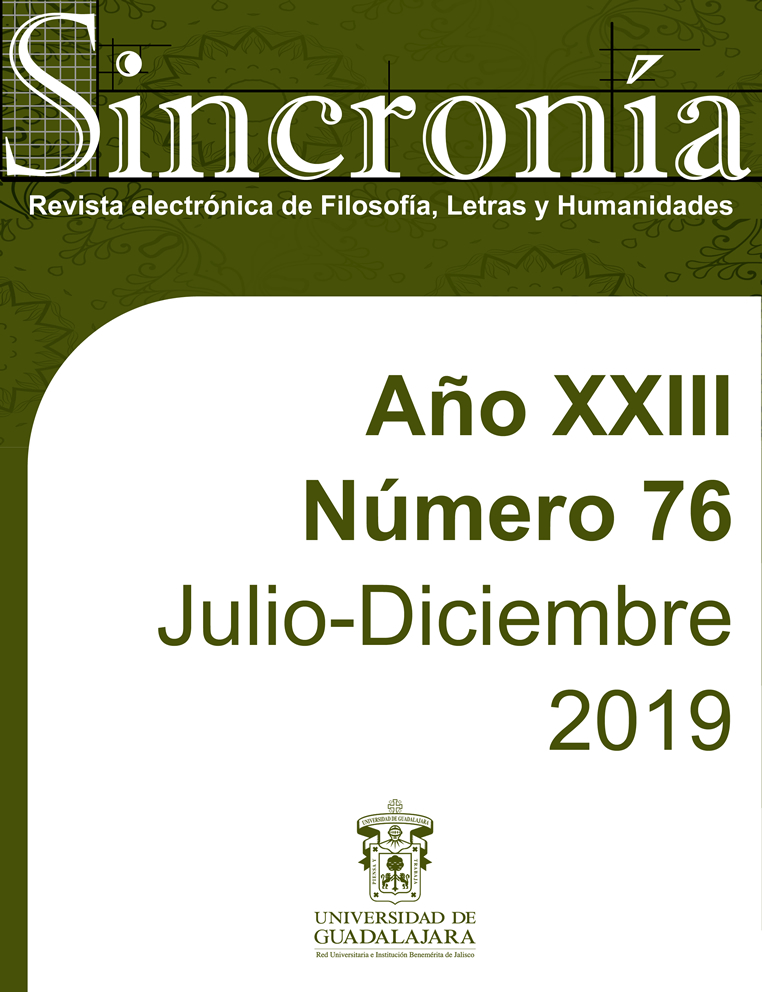Visual and literary representations in dialogue: chaos in socials and marginals sectors in Mexico’s and Cuba’s Costumbrismo
Keywords:
Violence, Linati, Landaluze, Literate perspective, Lithography, Costumbrismo articlesAbstract
Costumbrismo in Latin America had a very important social function: to unify the nation and create a sense of identity within the geographical territory of specific countries. However, not all the representations followed the same mold. In Mexico, Claudio Linati made a series of lithographs accompanied by articles published under the title Trajes civiles, militares y religiosos de México in 1828. In some cases, it’s possible to perceive that the lithography does not play a harmonious role with the Costumbrismo articles: there are elements that suggest a chaotic and violent behavior in some marginal social and cultural types of eighteenth-century Mexico. This Costumbrismo, keeping the social and temporal distance, converses in a suggestive way with some lithographs about Cuba by Victor Patricio de Landaluze, and, also, with the articles that accompany these works in the book Tipos y costumbres de la Isla de Cuba by Bachiller y Morales and Landaluze. The thematic line that places a dialogue in both expressions is the hint of violence and chaos in marginal sectors.
This work analyzes on the aforementioned topics through lithographs and the articles and seeks to relate two different geographical areas of Costumbrismo, noting their similarities and differences.
Downloads
References
Bachiller, A., y de Landaluze, V. P. (1881). Tipos y costumbres de la isla de Cuba. La Habana: Miguel de Villa.
Bobadilla, G. F. (2013). Literatura y cultura mexicana del siglo XIX: Lecturas y relecturas críticas e historiográficas. Hermosillo: Universidad de Sonora.
De Landaluze, V.P. (1886). Día de reyes en la Habana. Museo Nacional de Bellas Artes de Cuba. Recuperado de http://www.bellasartes.co.cu/obra/victor-patricio-landaluze-dia-de-reyes-en-la-habana.
Escudero, M. (2014). “El Día de Reyes” de Federico Mialhe: La importancia del grabado para el estudio de la iconografía musical cubana decimonónica. Cuadernos de iconografía musical, vol. 1 (1), 61-89.
Gómez, L. (2010). El discurso colonial en la iconografía cubana: Paisaje, urbanización y narrativas de lo rural del siglo XIX. G. Müller & E. Ottmar (Eds.), Caleidoscopios coloniales: Transferencias culturales en el Caribe del siglo XIX, (pp.121-138). Madrid: Iberoamericana Editorial.
González, R. (2010). Fiestas y origen de la nación cubana. G. Müller & E. Ottmar (Eds.), Caleidoscopios coloniales: Transferencias culturales en el Caribe del siglo XIX, (pp.67-81). Madrid: Iberoamericana Editorial.
Linati, C. (1981). Trajes civiles, militares y religiosos de México (Edición Facsimilar) Librería Manuel Porrua, S.A., Librería 1981.
Peñas, Ana. (2011). Entre literatura y pintura: poética pictórica del artículo de costumbres. B. Rodríguez & R. Gutiérrez (Eds.), Literatura ilustrada decimonónica: 57 perspectivas, (pp.625-638). Cantabria: PUbliCan, Ediciones de la Universidad de Cantabria.
Pérez, A. (2007). Actores, escenarios y relaciones sociales en tres publicaciones periódicas mexicanas de mediados del siglo XIX. Historia Mexicana, vol. LVI (4), 1163-1199.
Rodríguez, O. M. (1998). Landaluze: Pintor de costumbres. Anales del museo de América, (6), 85-93.
Villegas, F. (2011). El costumbrismo americano ilustrado: el caso peruano. Imágenes originales en la era de la reproducción técnica. Anales del museo de América (19), 7-67.
Downloads
Published
How to Cite
Issue
Section
License
Copyright (c) 2019 Mexico’s and Cuba’s Costumbrismo. Jesús Adalberto Campaña Fimbres

This work is licensed under a Creative Commons Attribution-NonCommercial 4.0 International License.
You are free to:
- Share — copy and redistribute the material in any medium or format
- Adapt — remix, transform, and build upon the material
- The licensor cannot revoke these freedoms as long as you follow the license terms.
Under the following terms:
- Attribution — You must give appropriate credit , provide a link to the license, and indicate if changes were made . You may do so in any reasonable manner, but not in any way that suggests the licensor endorses you or your use.
- NonCommercial — You may not use the material for commercial purposes .
- No additional restrictions — You may not apply legal terms or technological measures that legally restrict others from doing anything the license permits.



























